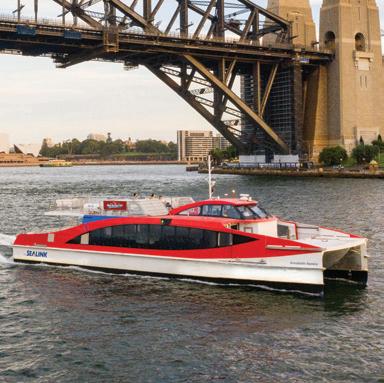
3 minute read
FEATURE
By Alec Smart
BETWEEN early May until late August, whales journey northwards through the Tasman Sea to the Coral Sea, and out into the South Pacific Ocean, many of them in close proximity to the shore.
Advertisement
From mid-August until late November the cetaceans return; the early southbound travellers on route to the Southern Ocean bypass the late northbound, often socialising as they cross paths.
Humpbacks, which feature distinctive fluted chins and long fins with up to 11 bumps known as ‘tubercles’, are, along with southern right whales, the most common of the migratory cetaceans in our waters. Around 30,000 (of the approximately 80,000 humpbacks worldwide) travel up and down the east coast of Australia every year.
Humpbacks and grey whales travel the longest distances of all whales – some swim a 10,000km round trip during their migratory cycle! Males often leap completely out of the water - known as ‘breaching’ - during demonstrations of strength generally intended to impress females.
However, only a few species of dolphins migrate, often travelling in pods among the whales, and they trek significantly shorter distances, preferring instead to follow the seasonal movements of their favourite fish prey.
BAY-BREAKERS
Whales frequently pause to rest or socialise in bays and sheltered coves during their migration.
Bondi, for example, receives occasional visitors. On 6 June 2023, a small pod of around six whales were filmed frolicking in the bay. On 31 May 2022, curiosity got the better of two young humpback whales that swam in to closely inspect a group of three ocean swimmers returning to Bondi Beach. The incident was filmed by a drone and made national news.
Whale Watching boat cruises around Sydney: captaincook.com.au/sydney-harbour-cruises/explore/whale-watching oceanextreme.com.au
On 9 July 2013, surfer Bishan Rajapakse was knocked unconscious when a 15-metre humpback flicked him off his board with a swish of its tail, just 70 metres offshore. Fellow surfers transported the concussed rider in to the beach, who later joked, “maybe it was giving me a high five!”
Typically among the last southbound stragglers coming close to shore in October-November are the new-born calves on their first long-distance journey south, accompanied by their mothers. They usually swim closer to the shoreline to avoid hungry predators, especially orca, which roam in packs seeking vulnerable young whales on which to feed.
Cetacean Facts
The word ‘cetacean’ is derived from the Ancient Greek ‘ketus’, meaning ‘monster-sized fish’, although they are not fish but warm-blooded mammals that give birth to live young, breathing air through a nostril ‘blowhole’, not filtered through gills.
There are 86 species of whales, dolphins and porpoises worldwide - are all marine-dwelling carnivores with diets that range from miniscule plankton to fish to other whales.
45 species of cetacean are found in Australian waters, including 10 large whales, 20 smaller whales, 14 dolphins and a single breed of porpoise. Some of them are seasonal, others resident all year round.
Cetaceans can be divided into two categories of feeders: Baleen, which have thin, frayed-end strainers for teeth through which they filter small marine creatures like plankton and fish.
Toothed, which generally prey on fish and squid, although some, like orca (aka “killer whales”, which are actually large dolphins and not whales, despite their name), also hunt seals or other cetaceans.
WHERE TO WATCH WHALES?
There are several high vantage points along the Sydney coastline from which to view whales, including: Ben Buckler Point, north of Bondi Beach; Burrows Park, Clovelly; and The Gap at South Head.

Further south, Magic Point, Malabar, and Solander Point at Kurnell are popular whale-watching spots.
On the Northern Beaches the new Burragula and Yiningma lookouts on North Head offer spectacular sea views, or Long Reef Headland and Barrenjoey Lighthouse.
Baleen whales sighted off the coast of Sydney include: Bryde’s, fin, humpback, minke (Antarctic and its dwarf subspecies), right (both southern and pygmy) and sei whales. Blue whales too, albeit once in a blue moon.

Toothed whales witnessed offshore include: southern bottlenose, pilot (long and short-finned), melon-headed, sperm (including pygmy and dwarf sub-species), and several ‘beaked’ species (Andrew’s, Arnoux’s, Blainville’s, Cuvier’s, ginkgo-toothed, Gray’s, Shepherd’s and straptoothed).
Several species of dolphins inhabit the coastal waters around Sydney, including bottlenose, common, dusky, hump-backed, Indo-Pacific, pantropical, Risso’s, roughtoothed, spinner (which perform spectacular, corkscrew-like acrobatic flips), striped, and the orcas (including false killer whales and pygmies). Some dolphins swim into bays to feed or even surf the waves breaking close to shore!
If you want to be amongst the action, Captain Cook Cruises are running Whale Watching tours right through to the 5th of November. You can get out early on a 10:00am

“Humpbacks and grey whales travel the longest distances of all whales – some swim a 10,000km round trip during their migratory cycle!” cruise, or mid afternoon at 1:15pm. The best part, you’re guaranteed to see a whale or you cruise again for free. Book in advance, cruises fill up quickly - you can check availability online - www.captaincook.com.au/exploresydney-sightseeing/whale-watching-sydney

MORNING AND AFTERNOON DEPARTURES
Approx. 2.5-hour family-friendly cruise

Expert live commentary
Comfortable indoor and outdoor seating
Whale guaranteed or cruise again for free*
FROM $69 PER ADULT









